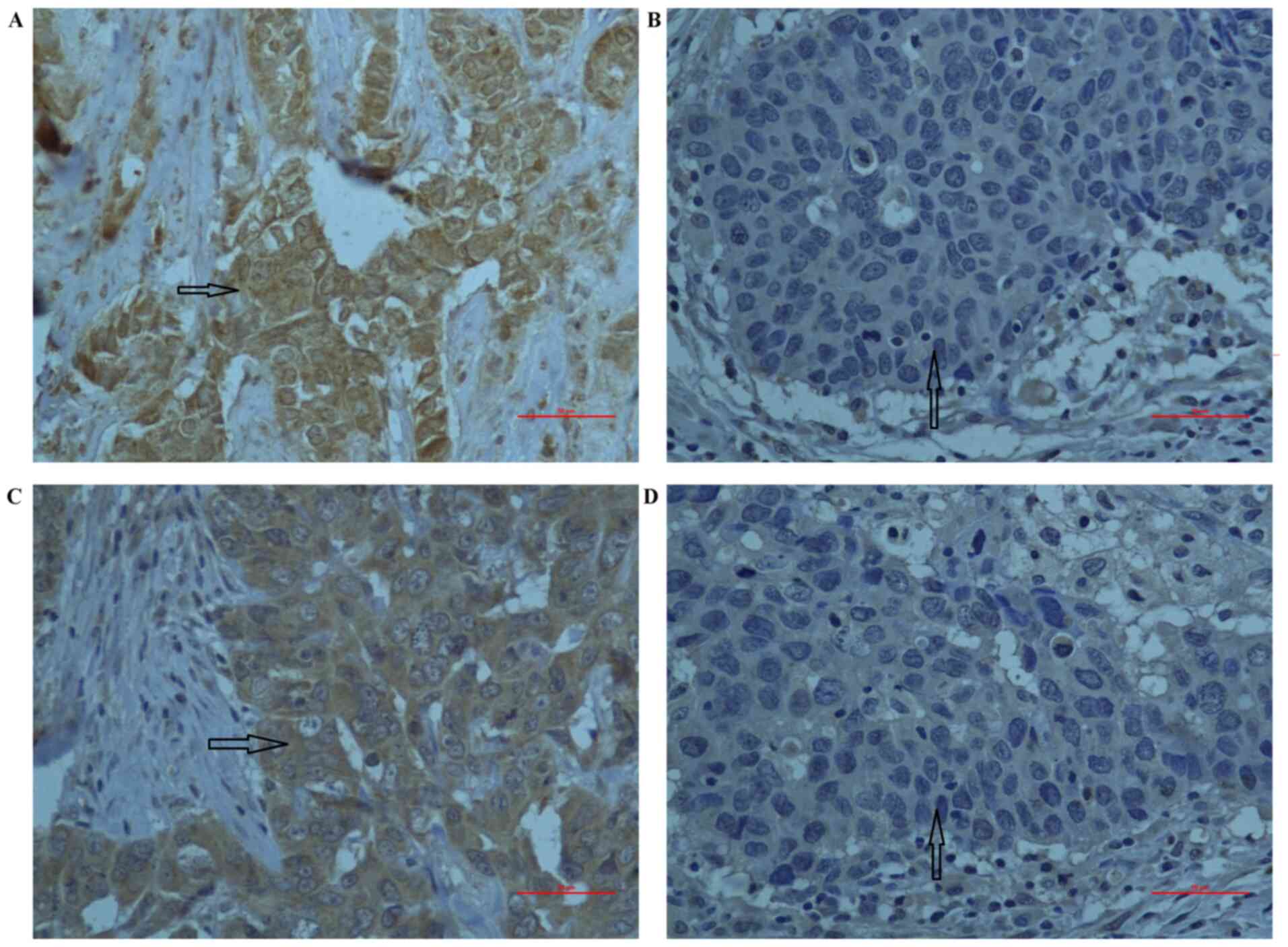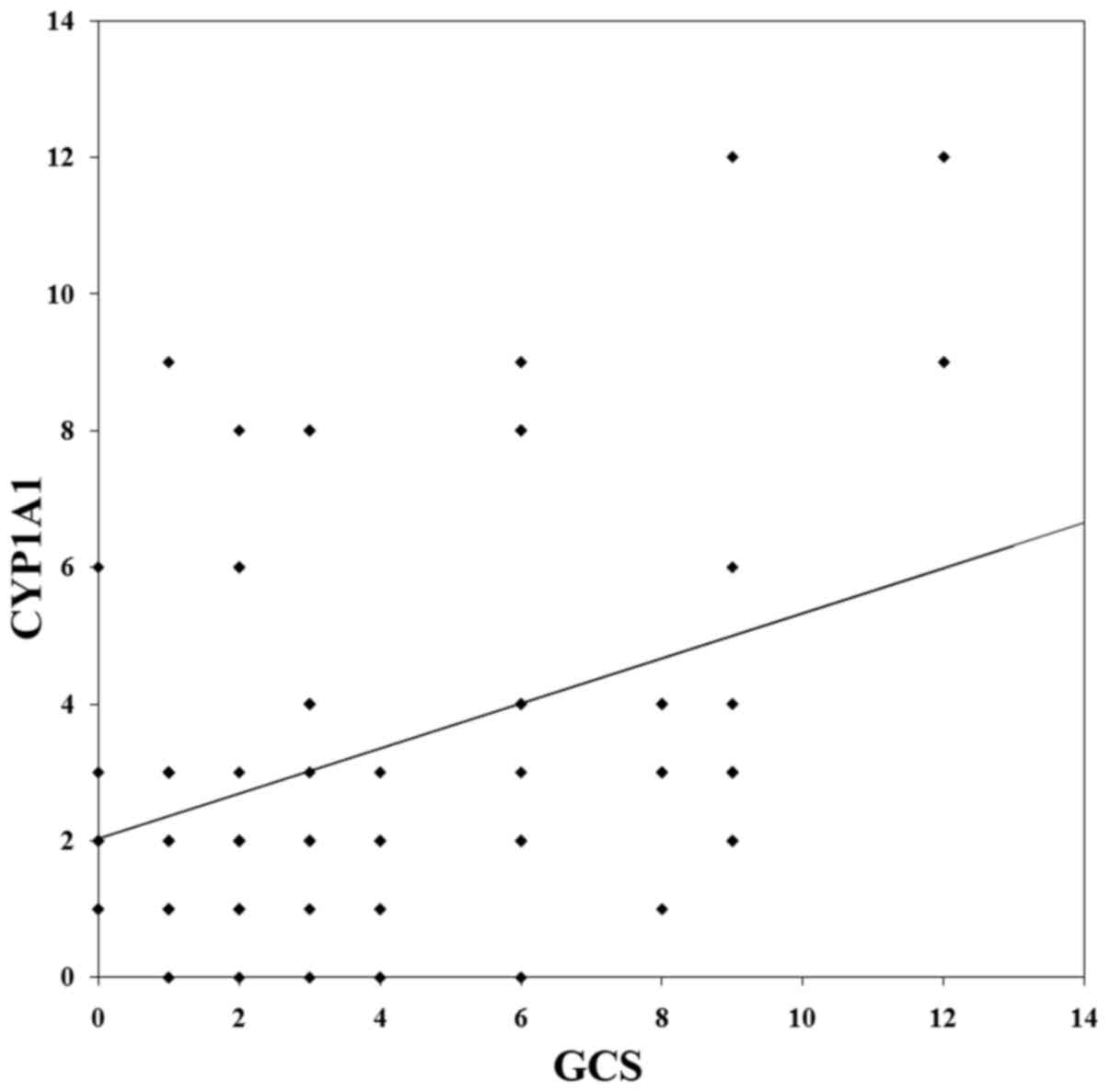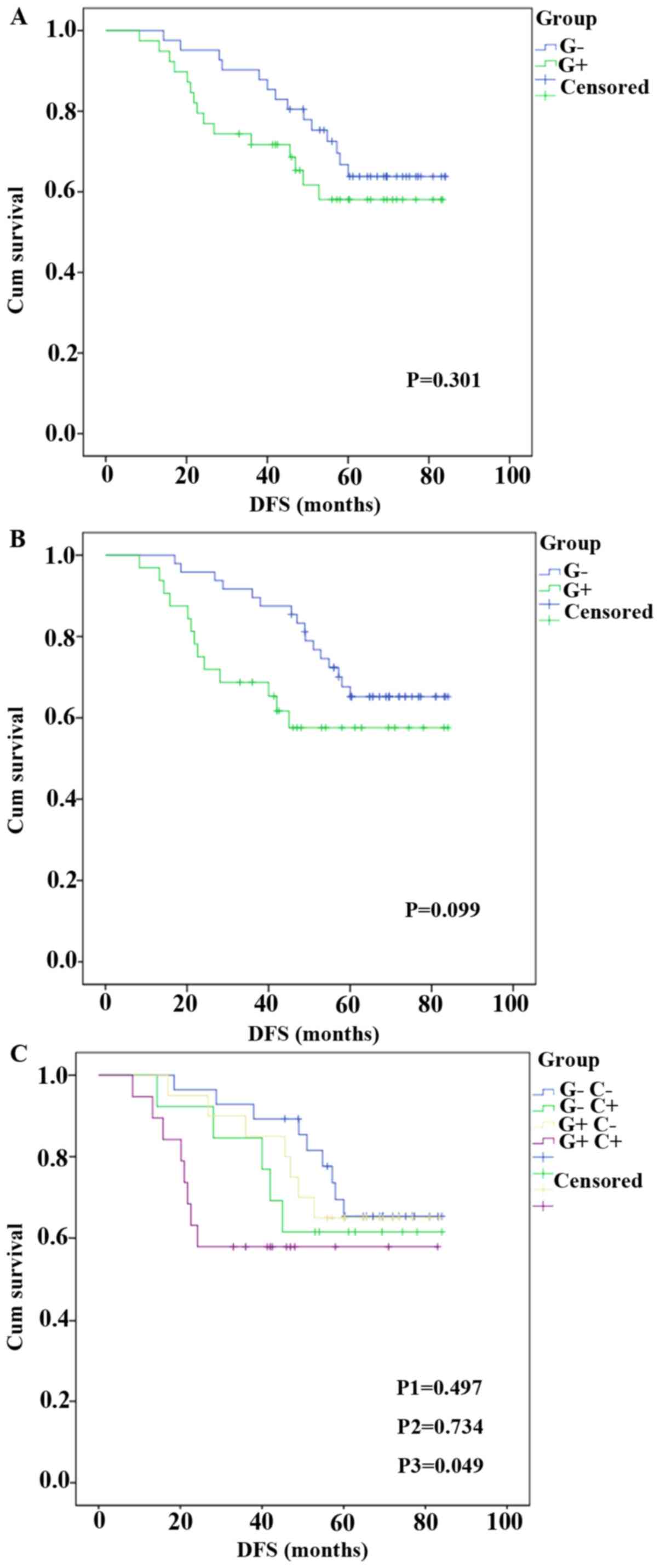|
1
|
Allemani C, Weir HK, Carreira H, Harewood
R, Spika D, Wang XS, Bannon F, Ahn JV, Johnson CJ, Bonaventure A,
et al: Global surveillance of cancer survival 1995-2009: Analysis
of individual data for 25,676,887 patients from 279
population-based registries in 67 countries (CONCORD-2). Lancet.
385:977–1010. 2015.PubMed/NCBI View Article : Google Scholar
|
|
2
|
Pareja F and Reis-Filho JS:
Triple-negative breast cancers-a panoply of cancer types. Nat Rev
Clin Oncol. 15:347–348. 2018.PubMed/NCBI View Article : Google Scholar
|
|
3
|
Wolff AC, Hammond MEH, Allison KH, Harvey
BE, Mangu PB, Bartlett JMS, Bilous M, Ellis IO, Fitzgibbons P,
Hanna W, et al: Human epidermal growth factor receptor 2 testing in
breast cancer: American society of clinical oncology/college of
american pathologists clinical practice guideline focused update. J
Clin Oncol. 36:2105–2122. 2018.PubMed/NCBI View Article : Google Scholar
|
|
4
|
Keenan TE and Tolaney SM: Role of
immunotherapy in triple-negative breast cancer. J Natl Compr Canc
Netw. 18:479–489. 2020.PubMed/NCBI View Article : Google Scholar
|
|
5
|
Garrido-Castro AC, Lin NU and Polyak K:
Insights into molecular classifications of triple-negative breast
cancer: Improving patient selection for treatment. Cancer Discov.
9:176–198. 2019.PubMed/NCBI View Article : Google Scholar
|
|
6
|
Chaudhary LN, Wilkinson KH and Kong A:
Triple-negative breast cancer: Who should receive neoadjuvant
chemotherapy? Surg Oncol Clin N Am. 27:141–153. 2018.PubMed/NCBI View Article : Google Scholar
|
|
7
|
Lebert JM, Lester R, Powell E, Seal M and
McCarthy J: Advances in the systemic treatment of triple-negative
breast cancer. Curr Oncol. 25 (Suppl 1):S142–S150. 2018.PubMed/NCBI View Article : Google Scholar
|
|
8
|
Asaoka M, Narui K, Suganuma N, Chishima T,
Yamada A, Sugae S, Kawai S, Uenaka N, Teraoka S, Miyahara K, et al:
Clinical and pathological predictors of recurrence in breast cancer
patients achieving pathological complete response to neoadjuvant
chemotherapy. Eur J Surg Oncol. 45:2289–2294. 2019.PubMed/NCBI View Article : Google Scholar
|
|
9
|
De Mattos-Arruda L, Shen R, Reis-Filho JS
and Cortés J: Translating neoadjuvant therapy into survival
benefits: One size does not fit all. Nat Rev Clin Oncol.
13:566–579. 2016.PubMed/NCBI View Article : Google Scholar
|
|
10
|
Walsh EM, Shalaby A, O'Loughlin M, Keane
N, Webber MJ, Kerin MJ, Keane MM, Glynn SA and Callagy GM: Outcome
for triple negative breast cancer in a retrospective cohort with an
emphasis on response to platinum-based neoadjuvant therapy. Breast
Cancer Res Treat. 174:1–13. 2019.PubMed/NCBI View Article : Google Scholar
|
|
11
|
Telli ML, Timms KM, Reid J, Hennessy B,
Mills GB, Jensen KC, Szallasi Z, Barry WT, Winer EP, Tung NM, et
al: Homologous recombination deficiency (HRD) score predicts
response to platinum-containing neoadjuvant chemotherapy in
patients with triple-negative breast cancer. Clin Cancer Res.
22:3764–3773. 2016.PubMed/NCBI View Article : Google Scholar
|
|
12
|
Ryspayeva D, Lyashenko A, Dosenko I,
Kostryba O, Koshyk O, Krotevych M and Smolanka I: Predictive
factors of pathological response to neoadjuvant chemotherapy in
patients with breast cancer. J BUON. 25:168–175. 2020.PubMed/NCBI
|
|
13
|
von Minckwitz G, Untch M, Blohmer JU,
Costa SD, Eidtmann H, Fasching PA, Gerber B, Eiermann W, Hilfrich
J, Huober J, et al: Definition and impact of pathologic complete
response on prognosis after neoadjuvant chemotherapy in various
intrinsic breast cancer subtypes. J Clin Oncol. 30:1796–1804.
2012.PubMed/NCBI View Article : Google Scholar
|
|
14
|
Miyashita M and Ishida T: Prospect of
immunotherapy in neoadjuvant/adjuvant treatment for early breast
cancer. Chin Clin Oncol. 9(28)2020.PubMed/NCBI View Article : Google Scholar
|
|
15
|
Loibl S, Weber KE, Timms KM, Elkin EP,
Hahnen E, Fasching PA, Lederer B, Denkert C, Schneeweiss A, Braun
S, et al: Survival analysis of carboplatin added to an
anthracycline/taxane-based neoadjuvant chemotherapy and HRD score
as predictor of response-final results from GeparSixto. Ann Oncol.
29:2341–2347. 2018.PubMed/NCBI View Article : Google Scholar
|
|
16
|
Mohammed AA, Elsayed FM, Algazar M, Rashed
HE and Anter AH: Neoadjuvant chemotherapy in triple negative breast
cancer: Correlation between androgen receptor expression and
pathological response. Asian Pac J Cancer Prev. 21:563–568.
2020.PubMed/NCBI View Article : Google Scholar
|
|
17
|
Xu HB, Xu LZ, Li L, Fu J and Mao XP:
Reversion of P-glycoprotein-mediated multidrug resistance by
guggulsterone in multidrug-resistant human cancer cell lines. Eur J
Pharmacol. 694:39–44. 2012.PubMed/NCBI View Article : Google Scholar
|
|
18
|
Liu YY, Patwardhan GA, Xie P, Gu X,
Giuliano AE and Cabot MC: Glucosylceramide synthase, a factor in
modulating drug resistance, is overexpressed in metastatic breast
carcinoma. Int J Oncol. 39:425–431. 2011.PubMed/NCBI View Article : Google Scholar
|
|
19
|
Sun Y, Zhang T, Gao P, Meng B, Gao Y, Wang
X, Zhang J, Wang H, Wu X, Zheng W and Zhou G: Targeting
glucosylceramide synthase downregulates expression of the multidrug
resistance gene MDR1 and sensitizes breast carcinoma cells to
anticancer drugs. Breast Cancer Res Treat. 121:591–599.
2010.PubMed/NCBI View Article : Google Scholar
|
|
20
|
Itoh M, Kitano T, Watanabe M, Kondo T,
Yabu T, Taguchi Y, Iwai K, Tashima M, Uchiyama T and Okazaki T:
Possible role of ceramide as an indicator of chemoresistance:
Decrease of the ceramide content via activation of glucosylceramide
synthase and sphingomyelin synthase in chemoresistant leukemia.
Clin Cancer Res. 9:415–423. 2003.PubMed/NCBI
|
|
21
|
Boojar MMA, Boojar MMA, Golmohammad S and
Bahrehbar I: Data on cell survival, apoptosis, ceramide metabolism
and oxidative stress in A-494 renal cell carcinoma cell line
treated with hesperetin and hesperetin-7-O-acetate. Data Brief.
20:596–601. 2018.PubMed/NCBI View Article : Google Scholar
|
|
22
|
Zhang X, Wu X, Su P, Gao Y, Meng B, Sun Y,
Li L, Zhou Z and Zhou G: Doxorubicin influences the expression of
glucosylceramide synthase in invasive ductal breast cancer. PLoS
One. 7(e48492)2012.PubMed/NCBI View Article : Google Scholar
|
|
23
|
Liu J, Sun P and Sun Y, Liu A, You D,
Jiang F and Sun Y: Expression of glucosylceramide synthase in
invasive ductal breast cancer may be correlated with high estrogen
receptor status and low HER-2 status. Diagn Pathol.
9(22)2014.PubMed/NCBI View Article : Google Scholar
|
|
24
|
Harbeck N and Gluz O: Neoadjuvant therapy
for triple negative and HER2-positive early breast cancer. Breast.
34 (Suppl 1):S99–S103. 2017.PubMed/NCBI View Article : Google Scholar
|
|
25
|
Michael M and Doherty MM: Tumoral drug
metabolism: Overview and its implications for cancer therapy. J
Clin Oncol. 23:205–229. 2005.PubMed/NCBI View Article : Google Scholar
|
|
26
|
Runge D, Köhler C, Kostrubsky VE, Jäger D,
Lehmann T, Runge DM, May U, Stolz DB, Strom SC, Fleig WE and
Michalopoulos GK: Induction of cytochrome P450 (CYP)1A1, CYP1A2,
and CYP3A4 but not of CYP2C9, CYP2C19, multidrug resistance (MDR-1)
and multidrug resistance associated protein (MRP-1) by prototypical
inducers in human hepatocytes. Biochem Biophys Res Commun.
273:333–341. 2000.PubMed/NCBI View Article : Google Scholar
|
|
27
|
Yan YE, Wang H and Feng YH: Alterations of
placental cytochrome P450 1A1 and P-glycoprotein in tobacco-induced
intrauterine growth retardation in rats. Acta Pharmacol Sin.
26:1387–1394. 2005.PubMed/NCBI View Article : Google Scholar
|
|
28
|
Zhang J, Song J, Liang X, Yin Y, Zuo T,
Chen D and Shen Q: Hyaluronic acid-modified cationic nanoparticles
overcome enzyme CYP1B1-mediated breast cancer multidrug resistance.
Nanomedicine (Lond). 14:447–464. 2019.PubMed/NCBI View Article : Google Scholar
|
|
29
|
Sorf A, Hofman J, Kučera R, Staud F and
Ceckova M: Ribociclib shows potential for pharmacokinetic drug-drug
interactions being a substrate of ABCB1 and potent inhibitor of
ABCB1, ABCG2 and CYP450 isoforms in vitro. Biochem Pharmacol.
154:10–17. 2018.PubMed/NCBI View Article : Google Scholar
|
|
30
|
Chen Y, Huang W, Chen F, Hu G, Li F, Li J
and Xuan A: Pregnane X receptors regulate CYP2C8 and P-glycoprotein
to impact on the resistance of NSCLC cells to Taxol. Cancer Med.
5:3564–3571. 2016.PubMed/NCBI View Article : Google Scholar
|
|
31
|
Yu KD, Liu GY, Zhou XY, Zhou Y, Wu J, Chen
CM, Shen ZZ and Shao ZM: Association of HER-2 copy number and
HER-2/CEP-17 ratio with neoadjuvant taxane-containing chemotherapy
sensitivity in locally advanced breast cancer. Oncologist.
17:792–800. 2012.PubMed/NCBI View Article : Google Scholar
|
|
32
|
Azam F, Latif MF, Farooq A, Tirmazy SH,
AlShahrani S, Bashir S and Bukhari N: Performance status assessment
by using ECOG (Eastern cooperative oncology group) score for cancer
patients by oncology healthcare professionals. Case Rep Oncol.
12:728–736. 2019.PubMed/NCBI View Article : Google Scholar
|
|
33
|
Zaheed M, Wilcken N, Willson ML, O'Connell
DL and Goodwin A: Sequencing of anthracyclines and taxanes in
neoadjuvant and adjuvant therapy for early breast cancer. Cochrane
Database Syst Rev. 2(Cd012873)2019.PubMed/NCBI View Article : Google Scholar
|
|
34
|
Rastogi P, Anderson SJ, Bear HD, Geyer CE,
Kahlenberg MS, Robidoux A, Margolese RG, Hoehn JL, Vogel VG, Dakhil
SR, et al: Preoperative chemotherapy: Updates of national surgical
adjuvant breast and bowel project protocols B-18 and B-27. J Clin
Oncol. 26:778–785. 2008.PubMed/NCBI View Article : Google Scholar
|
|
35
|
Nakatsukasa K, Koyama H, Oouchi Y,
Imanishi S, Mizuta N, Sakaguchi K, Fujita Y, Fujiwara I, Kotani T,
Matsuda T, et al: Docetaxel and cyclophosphamide as neoadjuvant
chemotherapy in HER2-negative primary breast cancer. Breast Cancer.
24:63–68. 2017.PubMed/NCBI View Article : Google Scholar
|
|
36
|
Schneeweiss A, Möbus V, Tesch H, Hanusch
C, Denkert C, Lübbe K, Huober J, Klare P, Kümmel S, Untch M, et al:
Intense dose-dense epirubicin, paclitaxel, cyclophosphamide versus
weekly paclitaxel, liposomal doxorubicin (plus carboplatin in
triple-negative breast cancer) for neoadjuvant treatment of
high-risk early breast cancer (GeparOcto-GBG 84): A randomised
phase III trial. Eur J Cancer. 106:181–192. 2019.PubMed/NCBI View Article : Google Scholar
|
|
37
|
Jang N, Choi JE, Kang SH and Bae YK:
Validation of the pathological prognostic staging system proposed
in the revised eighth edition of the AJCC staging manual in
different molecular subtypes of breast cancer. Virchows Arch.
474:193–200. 2019.PubMed/NCBI View Article : Google Scholar
|
|
38
|
Cortazar P and Geyer CE Jr: Pathological
complete response in neoadjuvant treatment of breast cancer. Ann
Surg Oncol. 22:1441–1446. 2015.PubMed/NCBI View Article : Google Scholar
|
|
39
|
Ghobrial FEI, Eldin MS, Razek AAKA, Atwan
NI and Shamaa SSA: Computed tomography assessment of hepatic
metastases of breast cancer with revised response evaluation
criteria in solid tumors (RECIST) criteria (version 1.1):
Inter-observer agreement. Pol J Radiol. 82:593–597. 2017.PubMed/NCBI View Article : Google Scholar
|
|
40
|
Al-Dhfyan A, Alhoshani A and Korashy HM:
Aryl hydrocarbon receptor/cytochrome P450 1A1 pathway mediates
breast cancer stem cells expansion through PTEN inhibition and
beta-catenin and Akt activation. Mol Cancer. 16(14)2017.PubMed/NCBI View Article : Google Scholar
|
|
41
|
Liu J, Zhang X, Liu A, Zhang D, Su Y, Liu
Y, You D, Yuan L, Kong X, Wang X and Sun P: Altered methylation of
glucosylceramide synthase promoter regulates its expression and
associates with acquired multidrug resistance in invasive ductal
breast cancer. Oncotarget. 7:36755–36766. 2016.PubMed/NCBI View Article : Google Scholar
|
|
42
|
Livak KJ and Schmittgen TD: Analysis of
relative gene expression data using real-time quantitative PCR and
the 2(-Delta Delta C(T)) method. Methods. 25:402–408.
2001.PubMed/NCBI View Article : Google Scholar
|
|
43
|
Yam C, Mani SA and Moulder SL: Targeting
the molecular subtypes of triple negative breast cancer:
Understanding the diversity to progress the field. Oncologist.
22:1086–1093. 2017.PubMed/NCBI View Article : Google Scholar
|
|
44
|
Ozaki A, Takita M and Tanimoto T: A call
for improved transparency in financial aspects of clinical trials:
A case study of the CREATE-X trial in the New England journal of
medicine. invest New Drugs. 36:517–522. 2018.PubMed/NCBI View Article : Google Scholar
|
|
45
|
Pusztai L, Foldi J, Dhawan A, DiGiovanna
MP and Mamounas EP: Changing frameworks in treatment sequencing of
triple-negative and HER2-positive, early-stage breast cancers.
Lancet Oncol. 20:e390–e396. 2019.PubMed/NCBI View Article : Google Scholar
|
|
46
|
Diana A, Carlino F, Franzese E,
Oikonomidou O, Criscitiello C, De Vita F, Ciardiello F and Orditura
M: Early triple negative breast cancer: Conventional treatment and
emerging therapeutic landscapes. Cancers (Basel).
12(819)2020.PubMed/NCBI View Article : Google Scholar
|
|
47
|
Barton MK: Bevacizumab in neoadjuvant
chemotherapy increases the pathological complete response rate in
patients with triple-negative breast cancer. CA Cancer J Clin.
64:155–156. 2014.PubMed/NCBI View Article : Google Scholar
|
|
48
|
Schmid P, Salgado R, Park YH,
Muñoz-Couselo E, Kim SB, Sohn J, Im SA, Foukakis T, Kuemmel S, Dent
R, et al: Pembrolizumab plus chemotherapy as neoadjuvant treatment
of high-risk, early-stage triple-negative breast cancer: Results
from the phase 1b open-label, multicohort KEYNOTE-173 study. Ann
Oncol. 31:569–581. 2020.PubMed/NCBI View Article : Google Scholar
|
|
49
|
Garufi G, Palazzo A, Paris I, Orlandi A,
Cassano A, Tortora G, Scambia G, Bria E and Carbognin L:
Neoadjuvant therapy for triple-negative breast cancer: Potential
predictive biomarkers of activity and efficacy of platinum
chemotherapy, PARP- and immune-checkpoint-inhibitors. Expert Opin
Pharmacother. 21:687–699. 2020.PubMed/NCBI View Article : Google Scholar
|
|
50
|
Wang RX, Chen S, Jin X and Shao ZM: Value
of Ki-67 expression in triple-negative breast cancer before and
after neoadjuvant chemotherapy with weekly paclitaxel plus
carboplatin. Sci Rep. 6(30091)2016.PubMed/NCBI View Article : Google Scholar
|
|
51
|
Carey LA, Dees EC, Sawyer L, Gatti L,
Moore DT, Collichio F, Ollila DW, Sartor CI, Graham ML and Perou
CM: The triple negative paradox: Primary tumor chemosensitivity of
breast cancer subtypes. Clin Cancer Res. 13:2329–2334.
2007.PubMed/NCBI View Article : Google Scholar
|
|
52
|
Sano H, Wada S, Eguchi H, Osaki A, Saeki T
and Nishiyama M: Quantitative prediction of tumor response to
neoadjuvant chemotherapy in breast cancer: Novel marker genes and
prediction model using the expression levels. Breast Cancer.
19:37–45. 2012.PubMed/NCBI View Article : Google Scholar
|
|
53
|
Nøhr-Nielsen A, Bagger SO, Brünner N,
Stenvang J and Lund TM: Pharmacodynamic modelling reveals
synergistic interaction between docetaxel and SCO-101 in a
docetaxel-resistant triple negative breast cancer cell line. Eur J
Pharm Sci. 148(105315)2020.PubMed/NCBI View Article : Google Scholar
|
|
54
|
Zhang X, Li J, Qiu Z, Gao P, Wu X and Zhou
G: Co-suppression of MDR1 (multidrug resistance 1) and GCS
(glucosylceramide synthase) restores sensitivity to multidrug
resistance breast cancer cells by RNA interference (RNAi). Cancer
Biol Ther. 8:1117–1121. 2009.PubMed/NCBI View Article : Google Scholar
|
|
55
|
Weiss J, Gajek T, Köhler BC and Haefeli
WE: Venetoclax (ABT-199) might act as a perpetrator in
pharmacokinetic drug-drug interactions. Pharmaceutics.
8(5)2016.PubMed/NCBI View Article : Google Scholar
|
|
56
|
Liu YY, Gupta V, Patwardhan GA, Bhinge K,
Zhao Y, Bao J, Mehendale H, Cabot MC, Li YT and Jazwinski SM:
Glucosylceramide synthase upregulates MDR1 expression in the
regulation of cancer drug resistance through cSrc and beta-catenin
signaling. Mol Cancer. 9(145)2010.PubMed/NCBI View Article : Google Scholar
|
|
57
|
Kivistö KT, Kroemer HK and Eichelbaum M:
The role of human cytochrome P450 enzymes in the metabolism of
anticancer agents: Implications for drug interactions. Br J Clin
Pharmacol. 40:523–530. 1995.PubMed/NCBI View Article : Google Scholar
|
|
58
|
Reed L, Arlt VM and Phillips DH: The role
of cytochrome P450 enzymes in carcinogen activation and
detoxication: An in vivo-in vitro paradox. Carcinogenesis.
39:851–859. 2018.PubMed/NCBI View Article : Google Scholar
|
|
59
|
Wilson A, Urquhart BL, Ponich T, Chande N,
Gregor JC, Beaton M and Kim RB: Crohn's disease is associated with
decreased CYP3A4 and P-glycoprotein protein expression. Mol Pharm.
16:4059–4064. 2019.PubMed/NCBI View Article : Google Scholar
|
|
60
|
Stiborová M, Martínek V, Rýdlová H, Koblas
T and Hodek P: Expression of cytochrome P450 1A1 and its
contribution to oxidation of a potential human carcinogen
1-phenylazo-2-naphthol (Sudan I) in human livers. Cancer Lett.
220:145–154. 2005.PubMed/NCBI View Article : Google Scholar
|
|
61
|
Wang H and Wang WJ: Relationship between
CYP1A1 polymorphisms and invasion and metastasis of breast cancer.
Asian Pac J Trop Med. 6:835–838. 2013.PubMed/NCBI View Article : Google Scholar
|
|
62
|
Hafeez S, Ahmed A, Rashid AZ and Kayani
MA: Down-regulation of CYP1A1 expression in breast cancer. Asian
Pac J Cancer Prev. 13:1757–1760. 2012.PubMed/NCBI View Article : Google Scholar
|
|
63
|
Symmans WF, Peintinger F, Hatzis C, Rajan
R, Kuerer H, Valero V, Assad L, Poniecka A, Hennessy B, Green M, et
al: Measurement of residual breast cancer burden to predict
survival after neoadjuvant chemotherapy. J Clin Oncol.
25:4414–4422. 2007.PubMed/NCBI View Article : Google Scholar
|
|
64
|
Wang RX, Ji P, Gong Y, Shao ZM and Chen S:
Value of CXCL8-CXCR1/2 axis in neoadjuvant chemotherapy for
triple-negative breast cancer patients: A retrospective pilot
study. Breast Cancer Res Treat. 181:561–570. 2020.PubMed/NCBI View Article : Google Scholar
|
|
65
|
Dan J, Tan J, Huang J, Zhang X, Guo Y,
Huang Y and Yang J: The dynamic change of neutrophil to lymphocyte
ratio is predictive of pathological complete response after
neoadjuvant chemotherapy in breast cancer patients. Breast Cancer.
27:982–988. 2020.PubMed/NCBI View Article : Google Scholar
|
|
66
|
Ochi T, Bianchini G, Ando M, Nozaki F,
Kobayashi D, Criscitiello C, Curigliano G, Iwamoto T, Niikura N,
Takei H, et al: Predictive and prognostic value of stromal
tumour-infiltrating lymphocytes before and after neoadjuvant
therapy in triple negative and HER2-positive breast cancer. Eur J
Cancer. 118:41–48. 2019.PubMed/NCBI View Article : Google Scholar
|
|
67
|
Sikov WM, Berry DA, Perou CM, Singh B,
Cirrincione CT, Tolaney SM, Kuzma CS, Pluard TJ, Somlo G, Port ER,
et al: Impact of the addition of carboplatin and/or bevacizumab to
neoadjuvant once-per-week paclitaxel followed by dose-dense
doxorubicin and cyclophosphamide on pathologic complete response
rates in stage II to III triple-negative breast cancer: CALGB 40603
(Alliance). J Clin Oncol. 33:13–21. 2015.PubMed/NCBI View Article : Google Scholar
|

















